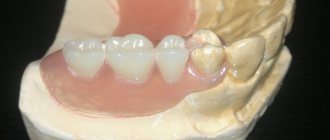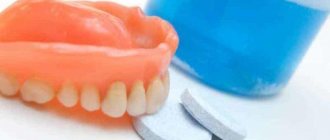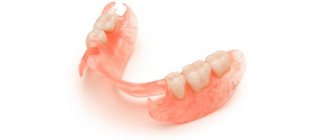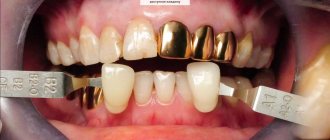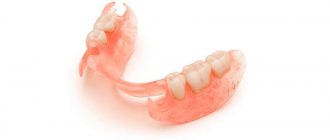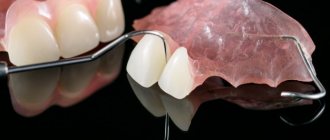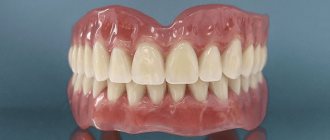Materials Manufacturing of removable dentures Manufacturing of fixed dentures Service life
The absence of teeth affects not only the function of chewing and speech, but also the emotional state, socialization and self-esteem. Prosthetics restores physiological functions, equalizes the emotional background, and increases self-confidence.
Making dentures is the result of a joint effort between a dentist and a technician. Each stage of work affects the final result. The manufacturing process depends on the type of structure and materials used.
There are the following types of restorations for restoring the dentition:
- Removable
. They are divided into full and partial. Full ones are used for edentia, when there are no teeth left at all. Partially removable ones are attached to the remaining teeth, which serve as support. - Fixed
. Unlike removable structures, inlays, crowns and bridges are fixed in the mouth for the entire period of use. They are removed only to replace them with new ones. - Conditionally removable
. Such dentures can be removed, but under certain conditions. The removable jaw is fixed on implants. You will not be able to remove the restoration yourself. The dentist will do this without difficulty, and after the necessary procedures, he will put it back.
Materials for the manufacture of prostheses
For permanent restorations, metals, ceramics and zirconium dioxide are used. Metal-ceramic crowns consist of 2 layers: a metal base, which is lined with a ceramic composition. Thick double walls require strong turning. Zirconium crowns are very durable, so the teeth need to be prepared minimally for them. New ceramic compositions, such as E-max, are quite durable and at the same time make it possible to choose the color of teeth of any shade.
The same materials can be used for conditionally removable prosthetics.
For removable dentures, the most important element is the base. The base is made from:
- Acrylic
- Acry Free
- Nylon
The hardest material is acrylic. Its disadvantages are microporosity and rapid wear. Acrylic contains substances that cause allergies. Pros: low cost and ease of processing.
Acry Free is a material that contains no allergens, it is softer and thinner than acrylic. It is easier to get used to such a product.
Nylon restorations fit comfortably in the mouth and do not cause allergies, but do not distribute the chewing load well enough due to their softness.
Metals and plastics are used for fastening elements of partial removable structures. And for the base - the same acrylic and plastics based on acrylic resins.
The service life of acrylic restorations is about 3 years, Acry Free and nylon restorations are 5 years. Dentures are replaced for several reasons. This could be a breakdown, an allergy, or a desire to replace an old design with a more modern one. The main thing is that removable structures do not stop bone loss. The relief of the oral cavity changes, the gums sag, and the restoration no longer fits.
Production stages
The manufacture of removable lamellar dentures, clasp or nylon, despite the differences in design features, follows the same scheme:
- An x-ray of the dental system is taken;
- The doctor takes impressions;
- The required structure is manufactured in the laboratory;
- The finished prosthesis is tried on;
- If necessary, the design is corrected;
- The prosthesis is installed.
The Interdentos dental laboratory uses innovative and reliable technologies for the manufacture of removable dentures, which makes it possible to make any design anatomically flawless and comfortable for the patient. You can order from us:
- Manufacturing of partial removable lamellar denture;
- Manufacturing of nylon structures;
- Manufacturing of a complete removable laminar denture
- Manufacturing of clasp construction.
The choice of a removable denture is made by the patient together with the doctor, taking into account the characteristics of the dental system, the general condition of the body and the available budget.
Manufacturing of removable dentures
The process of manufacturing restorations is called clinical-laboratory because it is carried out in close cooperation between the clinic and the laboratory. There are 4 clinical stages in the technology of removable dentures. Between them they carry out work in the laboratory.
First clinical stage
It is performed by an orthopedic dentist. Work begins with collecting anamnesis. The doctor collects information about health status, allergic reactions, and working conditions.
Then the dentist carries out:
- General examination
of the patient. The orthopedist pays attention to the bite, the structure of the jaws, and the condition of the prosthetic bed. The level of preservation of the remaining teeth, if any, is determined. - Special examination
. This includes motor and speech tests, registration of chewing and swallowing characteristics. An X-ray examination is performed and a tomography is performed. - Drawing up a treatment plan
. At this stage, the type of restoration and material for production are determined. - Taking impressions
. Using an orthopedic spoon, the doctor makes anatomical casts of the jaws. In simple cases, this is enough. For complex defects, individual spoons are made. The impressions are sent to the laboratory, where a technician gets to work.
Based on the plaster models, the technician makes an individual spoon. To do this, he uses plastics, thermoplastics or wax. After finishing the work, he hands the spoon to the doctor.
A custom tray is used by the orthopedist to obtain a functional impression. This method is used when:
- severe atrophy of bone tissue;
- some anatomical features (folds on the palatine bed, for example);
- with single-standing teeth, in the case of partial structures.
Second clinical stage
Determination of central occlusion (places of contact when closing the jaws).
Denture manufacturing techniques include casting plaster models and casting wax bases with occlusal ridges. Using them, the doctor determines the central relationship of the jaws. To do this, a wax model is placed in the mouth and height measurements are taken. The orthopedist places marks on the rollers to secure the teeth. At this stage, the color for future crowns is selected.
In the laboratory, the technician places the model in the occluder, selects the size, color and shape of the artificial teeth in accordance with the recommendations of the orthopedist and distributes them into the jaw. He then checks all structural elements.
When making clasp restorations, at this stage the frame is cast. It is ground and polished.
Third clinical stage
Fitting. The goal is to eliminate errors, check aesthetics and conduct speech tests. The doctor makes the adjustment himself; to eliminate complex errors, the product is sent to the laboratory.
After adjustment, installation is carried out. The moment the patient receives the restoration is considered the final clinical stage of the work.
The production of dentures in the clinic’s own laboratory helps the orthopedist and the technician to interact on an ongoing basis and clarify certain issues during the production of the restoration. In addition, working directly in the clinic, the technician is more interested in how the denture is made; the reputation of the clinic depends on his qualifications. This increases responsibility, which affects the quality of structures and ease of use.
Advantages and disadvantages
Like all materials used in dentistry, plastic has certain advantages and disadvantages.
Advantages:
- Efficiency of production without the use of expensive specialized equipment.
- Availability for various categories of patients.
- Attractive appearance.
- The minimal weight of the material allows it to be used in cases where it is necessary to protect the jaw tissue from serious pressure from artificial teeth.
Flaws:
- Products are contraindicated for people who are prone to allergies to artificial polymers.
- Short service life (approximately 24 months).
- Rapid loss of original appearance (shade changes under the influence of various food colorings).
- High probability of chips and cracks.
- The porous structure provides poor hygiene characteristics (accumulation of microscopic food particles and various bacteria).
- The need to prepare a significant amount of dental tissue due to the impressive thickness of the crown.
Fixed dentures
Fixed restorations include inlays, veneers, crowns and bridges. The manufacturing scheme differs only in small details. For example, let's take the manufacture of a bridge structure.
Preparation for the manufacture of a fixed denture begins with collecting anamnesis, making a diagnosis and preparing the teeth. The first clinical stage ends with the taking of impressions.
First laboratory stage
The impression technician makes a plaster cast and wax base with occlusal ridges. The model is then handed over to the doctor to determine the central occlusion. After this, the model goes back to the technician.
Second laboratory stage
The technician places the model in an articulator (a dental apparatus that simulates the closure of the jaws) and prepares models of ground teeth. Models crowns on abutment teeth and artificial teeth between them. Depending on how the denture is made, the technician makes metal crowns by casting, ceramic ones by pressing, and grinds zirconium crowns on a milling machine. The bridge is transferred to the orthopedist.
The dentist tries on the crowns and adjusts them. Notes any imperfections and sends them to the technician for final processing.
Third laboratory stage
The structure is polished and ground. In the case of metal ceramics, the metal base is processed and a ceramic coating is applied to it. The finished bridge is sent to the orthopedist, who fixes it on the patient’s teeth.
The production of dentures for the upper jaw follows the same protocol as for the lower jaw.
Plastic crowns
Installing plastic dental crowns is the most economical and efficient method of prosthetics. Their production occurs very quickly, so the patient can receive ready-to-use products in just one visit to a specialist. However, false teeth made of plastic are much more fragile and short-lived compared to their counterparts made of metal-ceramics or metal. In this regard, in most cases, such products are used as a temporary solution while more reliable crowns are made from other materials.
Porcelain vs plastic crowns
Porcelain designs also have advantages and disadvantages. It is necessary to select a specific material taking into account the individual characteristics of each patient. Thus, porcelain products are more reliable and perform their functions longer. But they have a negative impact on the condition of the teeth located on the opposite jaw, and also have a higher price.
Plastic products are inexpensive, quickly manufactured and do not affect the condition of the enamel of antagonist teeth. However, their disadvantages include a shorter service life and a higher likelihood of chipping and damage. Externally, plastic crowns do not differ from porcelain ones.
Reviews
— Albert
I really liked the level of service and attitude of the staff.
- Eugene
They saved me, there’s no other way to put it. Thank you for the speed and decency. Everything as promised!! I recommend to all!!!
- Svetlana
This is not the first time we have used denture repair services. As always FAST AND HIGH QUALITY! Thank you for your promptness and understanding!!
— Ksenia Vladimirovna
My daughter’s denture broke on the eve of her wedding, I was very upset, but Denta-Labor managed to fix it very quickly and efficiently, thank you.
Indications and contraindications
Plastic crowns are indicated in the following cases:
- the need to use a temporary structure during the production of a permanent prosthesis;
- aesthetic function when changing the shape or shade of teeth in the smile area;
- a permanent solution for restoring the basic functions of dental elements in case of congenital pathologies, damage and caries.
Contraindications to the installation of plastic structures are:
- childhood;
- deep bite;
- presence of allergies to the material;
- bruxism (teeth grinding).
Delivery areas:
- Altufyevo
- Bibirevo
- Biryulyovo East
- Central Administrative District
- Chertanovo
- Golyanovo
- Krasnopresnenskaya
- Kuntsevo
- Kuzminki
- Odintsovo
- Lyublino
- Medvedkovo
- Mitino
- Otradnoe
- Pavshinskaya floodplain
- Printers
- Polezhaevskaya
- River Station
- Ryazan Avenue
- SAO
- Northern Butovo
- Sokolniki
- NEAD
- SZAO
- Tushino
- Southern Administrative District
- SEAD
- South-Western Administrative District
- Voikovskaya
- Vykhino
- Company
- Zhulebino
- Aprelevka
- Dubki
- Krasnoznamensk
- Krylatskoe
- Cuban
- Nazaryevo
- Barvikha
- Vlasikha
- VNIISSOK
- Vnukovo
- Larks
Advantages and disadvantages
Acrylic dentures are in great demand due to the following advantages:
- low price compared to products made from other materials;
- high strength indicators and service life up to 8 years;
- the ability to manufacture products of different levels of complexity and shapes with the choice of the optimal shade;
- minimal weight, accelerating the process of addiction;
- no pressure on the supporting elements of the dentition, ensuring the preservation of natural tooth enamel in good condition;
- lightness and ease of care, thanks to which patients can remove and install the structure back without the help of a doctor.
However, there are some disadvantages:
- risk of soft tissue injury in the area of contact with the prosthesis;
- frequent allergies to plastic;
- the likelihood of damage to tooth enamel and further destruction of a completely healthy tooth if metal clasps are used;
- the porous structure of the material absorbs odors, food dyes and pathogens.
Hygiene
To ensure the longest service life of an acrylic plastic denture, it must be properly cared for by removing plaque and food residues with a soft toothbrush in the morning and evening.
Removable dentures must be disinfected once every 24 hours with a special solution to remove dirt and various microorganisms. If the denture is not removable, it is important to carefully clean the space between the teeth and the areas of contact between the structure and natural tissues. A toothbrush, pipe cleaners and floss will help with this.
At least once a year it is necessary to contact a specialist for the purpose of minimal restoration or relining of the plastic prosthesis. Relining is the correction of the shape of a structure from the inside, as a result of which the load on the tissue is distributed differently. This prevents too early atrophy and tissue damage.
When choosing plastic dentures and crowns, it is important to take into account all the advantages and disadvantages of such products. It is recommended to take into account the advice of professionals who will help you choose the best option for prosthetics.
Indications and contraindications
Experts highlight the following indications:
- A temporary solution while a permanent structure is being produced from more durable materials.
- A permanent solution for the loss of one or more elements of the dentition, including complete absence of teeth.
Contraindications:
- the presence of acute inflammation of the oral mucosa in the area of intended contact with the prosthesis;
- the presence of epilepsy or mental disorders;
- allergies to synthetic polymers;
- poor care of existing dental elements in the oral cavity.





